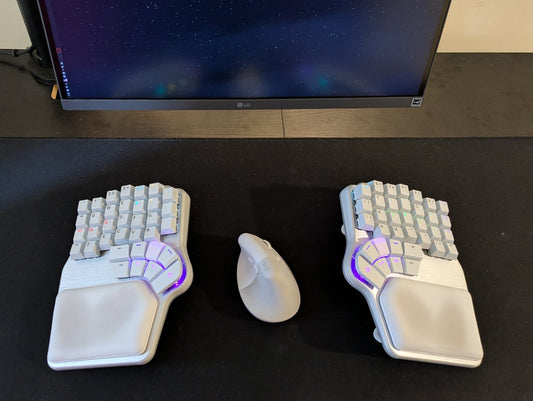What is tooling for manufacture?
The tooling is the different tools and machines you need to make to build your product. There are many different types of tooling, such as jigs and fixtures; cutting tools for milling and grinding machines; dies for cold forming sheet metal, forging and extrusion machines; and welding and inspection fixtures. For the Raise, the products that are made through plastic injection require an injection mold.- The special keycaps require a 10 cavity double injection mold.
- The stamped aluminium pieces, -such as the top panel, the Huble cover, and the joint pieces-, require stamp dies.
- The palm pads require a jig.
- The PCBs need testing jigs.
- And many more.


Why is tooling important?
The quality of a finished product, its components, its properties, the speed and accuracy with which it can be produced and the repeatability of manufacturing in high volumes, all depend on the precision and characteristics of the tooling. These tooling pieces come at a high cost. This means that our tooling needs to be designed and engineered to the highest quality, which is why we created the Golden Prototype. For the last few weeks, we’ve been finalizing the Golden Prototype and checking all design features very carefully with our suppliers. Even if it’s a difference of 0.1 or 0.05 millimeters, we still need to make the necessary modification to ensure that everything is precise for manufacturing. It has taken more time than expected but everything has to be top-notch.What do we need to finalize before creating the different tooling?
Base
We improved the structure of the base and made it sturdier. Our manufacturer already received the new 3D drawings and confirmed that the modifications can be done and manufactured.Huble
One thing that we changed with the Huble, but is not affecting the tooling, is its colour. Now it’s black and looks even more beautiful.
Top Panel
We slightly modified the tolerances between the two top panel pieces by 0.2 and made all the edges a bit rounder to avoid forming scratches. We’ve also adapted the holes for the switches to make it easier to fit and detach.
Metal Pins
We slightly modified the shape of the female pins. This was more of an aesthetic decision. Before it had a square shape. Now it’s round and it looks slicker. We also had to adapt the joint piece for this modification.
What are the components not related to the tooling?
Although there are a few things that can block the tooling, there are also pieces that are not directly related to the tooling. And after receiving the Golden Prototype, we decided to improve certain components to meet our high-quality standards.The laser-etched keycaps
The quality and design of the laser keycaps have already been approved. But when we received the Golden Prototype, we realized that we could improve the artwork. It is a minimal adjustment. Because the reverse LEDs are positioned at the top of the switch, the artwork at the lower part of the keycap does not emit a bright light. This affects some keycap languages, -such as Spanish, French, German, Nordic, and Japanese-, that have more than 2 symbols in one keycap.

Cables
The last sample of cables was a bit thin and too rigid. So a minor adjustment that we did was change the material inside to make it slightly thicker and more flexible.
Mylar sheet
The Mylar is the plastic sheet found at the bottom of the Raise. It will have an aluminium color -same color as the keyboard- on the exterior part, and a white color on the interior part. Remember in our last update we talked about creating a white box. We are now working on the artwork for the Mylar. We will put the Dygma logo at the bottom and in front of the LEDs so when the underglow changes color, you can see it shine through the artwork.
Packaging
We have already finalized the packaging design of the Raise. Initially, we had intended to have the switches and keycaps separate from the body and have you the user assemble it yourself. You can learn more about our packaging prototype here. But in the end, you will receive your Raise keyboard pre-assembled. For those who ordered extra keycaps and switches, you will have those in extra boxes but in the same package.Conclusion and next steps
We are working non-stop finalizing the components needed to start making the tooling. While the tooling is being made, we will finalize the rest of the pieces.
In the meantime, we are already putting together the many tooling contracts. Manel and Matt will be flying to Shenzhen in the first week of October to do the final checks in all the factories, and then sign the tooling agreements. They will also be able to create a proper planning schedule and will share them as soon as they come back.
By the second week of October, they will have a much more precise estimation of the delivery date. As you can imagine, this is a crucial time for the Raise development and we are all very excited about this trip!
Some of the toolings will take only 2 weeks to create, but there are some, like the tooling for the plastic injection pieces, that will take 35 days to create. So it’s still a bit of a wait.
When everything has been signed and the tooling has been done, we will move to manufacture. We would need to do the first batch of 50 units, check everything is correct, then do another 200 units, check those again, and then we will manufacture the rest.
As always, we will keep you all thoroughly informed about everything we do. Thank you for all of your patience and we are all looking forward to beginning manufacturing!









